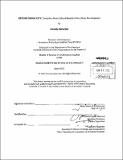Beyond Shock City : towards a new cultural model of riverfront development
Author(s)
Banerjea, Sreoshy
DownloadFull printable version (61.51Mb)
Alternative title
Towards a new cultural model of riverfront development
Other Contributors
Massachusetts Institute of Technology. Department of Architecture.
Advisor
James Wescoat.
Terms of use
Metadata
Show full item recordAbstract
In India, rivers hold profound meaning formed by sacred rituals, and traditions. Today, urban waterfront degradation has led to a focus on the greater good implemented through modern objectives of development, leading to a tension between past and present modes of city-river interface. In the state of Gujarat, India, the Sabarmati Riverfront divides Ahmedabad into the east and the west, the old city and the new city, characterized by populations varying in religious, social, and financial status. Due to the tension between the two sides, the river is a physical and sociological barrier between the two 'worlds'. Howard Spodek in Shock City portrays Ahmedabad stepped in shocking contradictions: a city of extraordinary economic growth and innovation, horrendous communal violence and appalling poverty. In order to address the divide, the Sabarmati Riverfront Development Corporation (SRFDC) was formed in 1997 to stitch together both sides and create a unique global identity for the city via a modern model of riverfront development. Today, as the decade long effort comes to fruition, it has expanded the outlook of its inhabitants but can also be critiqued as a heavy handed approach that has marginalized the lower rungs of society In order to demonstrate a new cultural model of riverfront development that situates itself between the modern model and traditional Indian riverfront urbanism, this thesis takes inspiration from multiple perspectives via the following three analyses: Firstly, a historiography of India riverfront urbanism leads up to the analysis of the Sabarmati Riverfront Development. Secondly, a conceptual framework is created via an analysis of an alternative cultural model along the Sabarmati, the Gandhi Ashram. Thirdly, a downstream sites' contemporary relationship with the Gandhi ashram is traced in order to propose and develop a new riverfront design framework through a cultural approach which integrates across multiple scales. This strategic focus area is developed as a contemporary embodiment of the inclusive spirit of the ashram, resulting in a landscape which is truly exemplary of the consciousness of unity, communal identity and diversity which can lift Ahmedabad beyond Shock City, beyond the current SRFD, and beyond the Gandhi Ashram today.
Description
Thesis (S.M. in Architecture Studies)--Massachusetts Institute of Technology, Dept. of Architecture, 2013. Cataloged from PDF version of thesis. Page 203 blank. Includes bibliographical references (p. 197-202).
Date issued
2013Department
Massachusetts Institute of Technology. Department of ArchitecturePublisher
Massachusetts Institute of Technology
Keywords
Architecture.